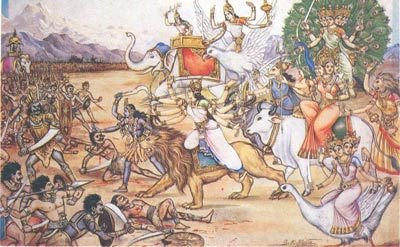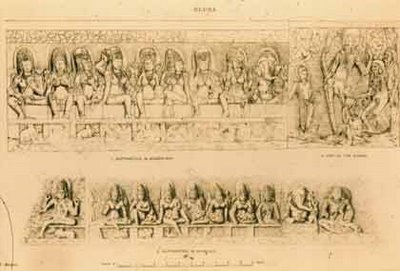VEERA-BHADRA-MURTHY
Veera-Bhadra though an attendant or one of Shiva Ghanas is usually identified with a variant form of Lord Shiva himself as one among the SIXTY-FOUR forms of Lord Shiva. He is said to have flashed forth from the matted locks of an indignant Shiva ( Rudra-Jata-Sambhava / Rudra-Kopa-Samudbhuta ). After Sati immolated herself in the Yagna of her father Daksha-Brahma, Shiva sent Veera-Bhadra to kill Daksha and destroy his sacrifice. So he is usually represented as Yanaka-Murthi or as one on his mission of destruction. There are several forms in which Veera-Bhadra is shown. Usually he is black in colour, three eyed, sporting a garland of severed heads or Skulls and having a Sword and Shield in two hands and Bow and Arrow in upper hands. He also wears Serpents as his ornaments.
As per Karanagama Bhadrakali stands on his left while Daksha with Goat head and horns is on his right in Anjali posture. Veera-Bhadra after beheading Daksha, at the bequest of the Gods replaced it with the head of a sacrificial Goat. Daksha after recovering his life remained in Shiva-Dhyana-Parayana.
Shilpa-Samgraha enumerates three varieties in Veera-Bhadra Images as
1. Sattvic ( Two armed ),
2. Rajasic ( Four armed ) and
3. Tamasic ( Eight armed ) in nature.
All of them have dark complexion, have Jata-Makuta and wield various arms.
Thus the Yoga-vira is seated in Sukasana with only Sword and Shield in his two arms and his right leg resting on the ground.
The Bhoga-vira is standing with four arms and has bow and arrow in the other two hands. He also wears a Munda-Mala and Daksha is seen standing on his right side.
The Vira-vira with eight arms, is shown in walking posture and carries a Trident, Sword, Arrow and Antelope in right arms and Skull-cup ( Kapala ), Shield ( Khadga ), Bow and Goad ( Mazhu ) in his left hands. This form is beautifully sculptured in Thiruvannamalai Temple and is worshipped as Aghora-Rudra-Murthi or Maha-Bhairava-Murthi.
In Shilpa-Ratna he is eight armed and rides a Vedala-Vahana ( Vampire ) and is surrounded by his Bhuta-Ghanas ( Nija-Gana-Sahita ). He is white complexioned and fierce looking. His tawny red matted locks is tied into a Knot in the top of his head ( Jata-Bhandha ) and adorned with the crescent Moon. His hands carry Battle-Axe, Hand-Drum, Sword, Shield, Skull-cap, Spear and his front two hands are in Abhaya-Varadha gestures. He is clad in Tiger skin.
In his Digambara Form, his body is adorned with many Serpents ( Bhujanga-Gana-Bhushana ) and his third eye is equally awesome. His eye brows are knit in anger and his hair is like flames ( Jvala-kesa ). His body is smeared with the blood of the enemies slain by him and he also carried a Gada ( Club ) and Trishula ( Trident ).
In Sapta-Matruka Panels we find Veera-Bhadra is in the right end and Ganapathi is in the left end flanking the Seven Mother Goddesses in between.
As per Roopamandanam :-
Veereswaracha Bhagavan Vrisharoodo Dhanur dhara :
Veena hastha : Trisulamcha Mathrunaam akradho bavedh //
Veerabhadra when placed along with the Sapta-Matrukas is seen holding the Bow, Arrow, Veena and Trisula, with a Varadha-Hasta in sitting posture with the Nandhi Vahana at his foot.
The Utsava-Murthi of Thiru-Pariyalur on the South Bank of Cauvery near Sembonnar Kovil ( In Mayiladuthurai-Tarangampadi Road ) is six armed with Trishula, Club, Sword, Bell, Skull-cup, and Axe. The Veerateswarar Temple is one of the Ashta-Veeratanam ( Eight Places of Valour of Shiva ) and the place is also called as Keezha-Parasalur. There is a sculpture of Daksha in Shiva-Pooja in the wall of Sanctorum. The Ardha-Jama Pooja ( Last pooja of the day before closing the temple ) is done for Lord Bhairava in this temple.
Karanagama depicts Veerabhadra as one who redeems our Sins, relieves all our sufferings, destroyed the Yagna of Daksha, has four arms, three eyes and sports a Jatamakuta akin to flames, has prominent teeth, wears a garland of bells and a garland of skulls. He is wearing a Paduka in his feet and wears ornaments in ankles. His neck is blue and his dress called “Kanchugam” is tightly worn around his loin. The weapons that he carries are the Sword, Shield, Bow, Arrow, Skull, and Pindi-palam. His complexion is fiery red and has fierce eyes. He is also represented with 32 arms in some Agama works.
According to Sri-Tattwa Nidhi, he is four-armed, three-eyed, has a Jatamakuta, has Sword and Arrow in his right arms and Bow and Gada in his left arms. He also has a beard and wears a garland of Skulls
( Mundamala ) and also of Bones ( Rundamala ). He has Paduka in his feet and wears Serpents on his body and ears and is accompanied by Bhadrakali. Daksha-Brahma in brahmanical form with Goat head and two horns is seen on his right in Anjali posture in Shiva-Dhyana.
Veerabhadra Dhyana-Shloka :-
Svethangam Sesha Bhushangam Khadga Veena dharam Subham /
Drutakrishnamrigam veeram Shaardhoolajidhavasam //
Arthonmeelita Netram dham Trinetramcha Jadataram /
Suganthi Pushpamalam Sri Veerabhadram Namamyaham //
“I worship thee, the White complexioned Veerabhadra, wearing Serpents as Ornaments, holds the Antelope in hand, wearing Tiger skin in his waist, with half closed eyes along with the Third eye in his forehead, his matted hair locked as Jatamakuta, and wearing a garland of Fragrant flowers”.
Another Dhyana Shloka of Veerabhadra :-
Shannetram Trimugam Bheemam Kalamegha Samaprabham /
Udharsijvalanam Neelaghatram Shatbhahu Shobinam //
Banapatrasi Soolekshu Chapa Khadga dharam Subham /
Bhoothapretadhi Dhamanm dushtarati vinasanam /
Meru vasam Mahesam tam Veerabhadram Namamyaham //
"I worship the Black complexioned Veerabhadra with Three Faces, Six eyes, in a Fierce form with flaming Fire as his hair-locks, and with six arms holding Banapatra, Sword, Trishulam, Bow, Arrow, and blesses all who worships him, tames and controls Bhutas and Pretas ( Demons and Vampires ), and kills all the evil enemies, and dwells forever in the Hill of Meru".
Amsumadbedagama Dhyana-Shloka :-
Chaturbhujam trinetram cha Jatamakuta manditham /
Saravabharana samyuktham swethavarnam vrushadvjam //
Soolam cha abhaya Hastham cha dakshinedhu karatvayam
Gadha varadha hastham cha Vama parshvey karathvayam //
Swetha Padmasanasoonam Vadavriksha Samasritam /
Veerabhadram Idhikyadam Brahmi roopam dhadha shrnu //
" I worship the White complexioned Lord Veerabhadra with four arms, three eyes, Jatamakutam, Sarva-abharanam ( variety of Jewellery ), Rishaba Kodi ( Flag with Nandhi ), Right arms having Trisula, Abhaya gesture, Left arms having Gadha and Varadha gestures, sitting under the Alamaram / Peepal Tree, on a White Lotus seat…"
Akasha-Veerabhadra Mantra :-
Kalarudra Rushihi :/
Jagadhee Chandaha :/
Veerabhadra Devata :/
Vam Beejam :/
Hoom Shakthihi :/
Dhyanam :-
Maragata Manineelam Kinginee Jalamaalam /
Prakadita Mugameesam Bhanu Soma-Aagni Netram ://
Hariharamasikedatraya Kradhandakra Hastham /
Vidhudharam ahi Bhusham Veerbhadram Namami : //
“I worship thee, Lord Veerabhadra, of Blue-Black complexion, wearing an Ornament of Bells, in a fierce looking form of Shiva with the Sun, Moon and Agni as three eyes, representing the Vibhuti of both Shiva and Vishnu, and holding the Sword, Shield and Club, wearing the Crescent Moon in his hair and Serpent garlands adorning the body...”
Mula Mantra :-
O Namo Veerabhadraya Vairi Vamsha Nivinasaya Sarvaloka Bayangaraya Beema Veshaya Hoom Phat Vijaya Vijaya Hreem Hoom Phat Svaha ׀
------------------------------------------------------------------------------------------------------
I have tried my best to collect as much materials as possible with my limited resources on Lord Veerabhadra and I welcome any additional information to enlighten everyone on the Glory of Worship of Veerabhadra. Even the picture depicted in this Blog has been created as per the Dhyana-Shloka given above as a representation of a DHUSHTA-NIGRAHA-ANUGRAHA-MURTHI of Lord Shiva.








 SAPTA-MATRUKAS
SAPTA-MATRUKAS